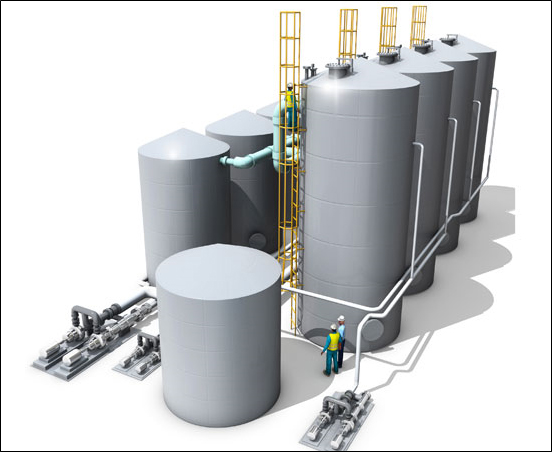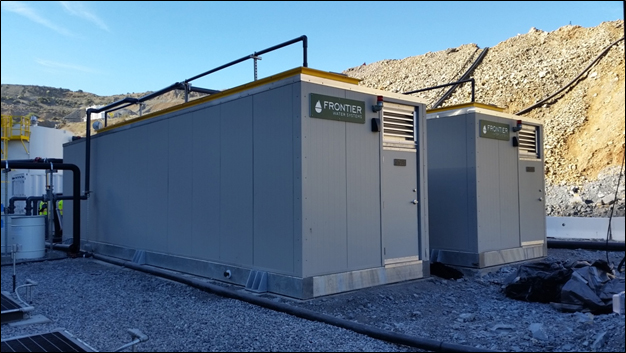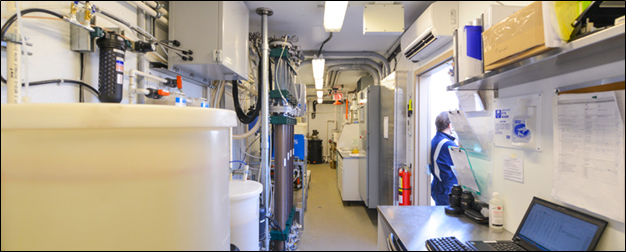Selenium Removal Technologies: A Review

By Mark Reinsel, Apex Engineering
Selenium has emerged as a water treatment contaminant of concern in industries such as mining, oil refining, and power generation. In southeastern Idaho phosphate mines, selenium has been a major issue for two decades and is currently the subject of a large-scale federally mandated cleanup effort. In British Columbia’s Elk River Valley coal mining operations, Teck Resources Ltd. is actively searching for methods to control and treat selenium discharges. The company, which currently operates five coal mines in the region, is in the midst of investing $600 million on water diversion and treatment facilities, aquatic monitoring programs, and R&D to improve selenium management (Missoulian, 2013).
Understanding the source, fate, and transport of selenium in oil refinery wastewater is also a challenge, along with subsequent treatment, for U.S. oil refineries with a selenium limit in their National Pollutant Discharge Elimination System (NPDES) wastewater permit. Desalter wash water originating from the sour water stripper is responsible for most of the selenium contribution to refinery wastewater. It has been found that treating low-flow, high-concentration isolated streams in a refinery is the most cost-effective approach, both for capital and O&M costs.
In 2014, the U.S. EPA implemented new Effluent Limitation Guidelines (ELGs) for nitrate, selenium, and mercury in flue gas desulfurization (FGD) wastewater in the power industry. Selenium and mercury are two major contaminants of concern in FGD wastewaters.
Selenium Chemistry
Selenium is an element with symbol Se and atomic number 34. It is located in the periodic table beneath elemental sulfur; selenium oxides (selenate and selenite) are chemically similar to sulfate.
Selenium is found in metal sulfide ores, where it partially replaces sulfur (Wikipedia, 2015). Selenium salts are toxic at high concentrations, but trace amounts are necessary for cellular function in many organisms, including animals. Selenium is an ingredient in many multivitamins and other dietary supplements, including infant formula.
The principal aqueous forms of inorganic selenium are selenate (Se6+) and selenite (Se4+). Selenate is typically much more difficult to treat and remove. Selenate predominates in oxidizing environments as SeO42-, while selenite is present in moderately reducing conditions as SeO32- or HSeO3-. One colleague recommends differentiating the two species phonetically based on their ease of treatment: he “likes” selenite and “hates” selenate.
Treatment Technologies
Selenium is removed from wastewater principally through either biological or chemical/physical processes. This article will describe those technologies, several technology providers, and other sources of information.
Biological Treatment
Dissolved selenium (selenite or selenate) can be biologically reduced by bacteria under anoxic conditions to elemental selenium, which is a pink-colored metal. This process requires a carbon source to serve as an electron donor and a several-hour hydraulic residence time (HRT), similar to biological denitrification. If nitrate is also present in the water, it will typically be preferentially reduced before bacteria reduce selenite/selenate. The typically low concentrations of selenium to be removed mean that lower doses of carbon, including methanol or molasses, can be used compared to denitrification. Biological treatment processes commonly require upstream treatment (to remove solids) and/or downstream treatment (to filter biomass, precipitated selenium, and possibly add dissolved oxygen) to meet discharge limits. One advantage of biological treatment is that both selenate (Se6+) and selenite (Se4+) species are reduced to elemental selenium.
Biological treatment systems, which are typically attached-growth reactors utilizing bacterial biofilm on a media surface, include packed bed reactors (PBRs), fluidized bed reactors (FBRs), moving bed biological reactors (MBBRs), and electro-biochemical reactors (EBRs). Attached growth systems are best-suited for growing sufficient biomass to treat wastewater, which typically contains low concentrations of selenium.
- The PBR is a downflow attached growth system. Filtration of suspended solids may be required to prevent media plugging, and periodic backflushing is needed to remove dead biomass. Typical media are sand or granular activated carbon (GAC). GE Water uses its ABMet process, a PBR, to biologically remove selenium with naturally occurring, non-pathogenic bacteria. Nitrate can be removed in the same process. ABMet bioreactors utilize a porous, high-surface area medium, typically GAC.

Schematic depicting GE Water’s ABMet biological process for selenium removal
- The FBR is an upflow attached growth system in which water passes through a granular solid medium at a high enough velocity to suspend the media. This provides maximum contact between contaminants and the bacteria attached to the medium. Typical media used are again GAC or sand. Envirogen Technologies, Inc. has designed a small-footprint FBR for selenium removal. The process reportedly produces effluent concentrations less than 5 ug/L, even in the presence of high levels of nitrate. Containerized FBR systems can be sized to treat a wide range of flows (100 to 3,000 gpm) and influent water qualities.

Frontier Water’s hybrid FBR containerized system for selenium removal at a California quarry. Each of the two modules have a design capacity of 250 gpm.
Frontier Water provides a hybrid FBR system for selenium removal. Frontier’s modular system, called SeHAWK™, has flow capacities of 50 to 1,000 gpm per unit with a smaller footprint than competitive systems. Frontier has reportedly installed bioreactors currently removing 430,000,000 mg/yr (950 lb/yr) of selenium from U.S. waters, with HRTs as low as 40 minutes.
- The MBBR is an FBR utilizing anoxic and aerobic treatment processes. It uses a proprietary high-surface area medium and includes post-treatment of suspended solids and precipitated selenium. The MBBR process by Veolia AnoxKaldnes™ has a small footprint, and is designed to handle high total suspended (TSS) concentrations and large hydraulic variations.
- The EBR has been used at a pilot scale to remove selenium and other inorganic contaminants from water. It reportedly overcomes the shortcomings of conventional bioreactors by using an applied low voltage (1 to 3 volts) to directly serve as an electron donor. The process claims to provide more efficient selenium removal with a shorter residence time and a smaller footprint. An initial EBR evaluation indicated over 25 percent lower capital costs and up to 50 percent lower O&M costs than conventional bioreactors and other treatment technologies.
Constructed wetland treatment systems (CWTSs) have also been utilized to successfully remove selenium and other metals. Nutrimens® is a nutrient source distributed by Tersus Environmental to aid the biological treatment process.
Chemical/Physical Treatment
These technologies include oxidation/reduction, iron co-precipitation, ion exchange (IX), and adsorption.
- Oxidation/reduction. Selenium species are rarely purposely oxidized, as this may place them in the difficult-to-remove selenate state. However, reduced species such as selenocyanate (common in stripped sour water in oil refining) require oxidation to selenite or selenate for biological treatment to be effective. A standard oxidant such as chlorine, hydrogen peroxide, or potassium permanganate can be used. Reduction is frequently accomplished through biological treatment or the following chemical treatment processes.
- Iron co-precipitation is a process in which precipitating relatively large amounts of ferric oxide/hydroxide is used to simultaneously remove low concentrations of other contaminants by capturing them within the ferric compounds. Iron co-precipitation effectively removes selenite but removes very little selenate. This process has been widely used at mine sites, and typically requires clarification and filtration downstream of the co-precipitation process, as it generates large amounts of sludge.
- In IX systems, selenate/selenite ions are exchanged for like-charged ions using specialty resins that are specifically for selenium. The resin capacity for selenium can be increased if competing anions such as nitrate and sulfate are not present or are removed first. After the resin capacity is reached, the resin requires regeneration. This concentrated regenerant must then be disposed of or further treated.
BioteQ has its Selen-IX™ process for selenium removal.This system is unique in that a small volume of spent regenerant solution is directed to a selenium electrochemical reduction step, where iron is added to form an iron-selenium solid (as in iron co-precipitation).The selenium-free solution is recycled back to the IX circuit, which concentrates the selenium into a sludge and eliminates the regenerant waste stream.

BioteQ’s mobile pilot plant using the Selen-IX process
- Adsorption utilizes a sorptive medium to reduce selenite and selenate to elemental selenium. Similar to IX, the adsorption vessel is operated in upflow media. Unlike IX, the medium cannot be regenerated. Media typically passes the Toxicity Characteristic Leaching Procedure (TCLP) when it is exhausted. One medium that has been demonstrated to be effective for selenate removal is sulfur-modified iron (SMI) nanoparticles. Veolia recommends a proprietary SeleniumZero® adsorption system to either polish MBBR effluent or as a stand-alone solution for lower-concentration streams.
Activated alumina has been used for selenium removal by Pureflow Filtration and others. An adsorptive activated alumina media and associated chemical treatment system provides an automated, low-maintenance treatment system. However, this process requires selenium to be in the selenite form.
Selenite vs. Selenate
Differences in treatment schemes for reduced selenium (selenite) vs. oxidized selenium (selenate) have been discussed. The first task for a potential treatment scheme, of course, is to identify the selenium oxidation state. Many analytical laboratories have this capability.
Selenite is typically simpler to remove than selenate. Here is a summary of how the various treatment technologies can be applied to selenite and selenate.
|
Technology |
Selenite |
Selenate |
|
Biological Treatment (PBR, FBR, MBBR, EBR, or CWTS) |
X |
X |
|
Reduction |
X |
X |
|
Iron Co-precipitation |
X |
|
|
Ion Exchange |
X |
X |
|
SMI |
|
X |
|
Activated Alumina |
X |
|
Other Options
Deep-well injection has also been used for wastewaters containing selenium. Deep-well injection technology was installed in 2013 at a Southern California utility to resolve environmental concerns over its discharge of spent cooling-tower water to the Salton Sea (AGID, 2013). The main concern here is the high capital cost of drilling high-capacity, deep (typically greater than 2,000 feet) wells capable of maintaining permeability over time.
Relevant Projects
Apex Engineering has undertaken selenium removal projects for several clients.
|
Industry |
Location |
Task |
Results |
|
Oil and Gas |
Montana |
Evaluate future discharge and treatment options |
Reviewed process, analyzed water quality data, recommended appropriate treatment technologies |
|
Mining |
Colorado |
Develop process for removing Se from mine water |
Researched and evaluated several treatment methods |
|
Mining |
Texas |
Develop treatment process to meet groundwater discharge limits |
Biological treatment achieved over 90% Se removal but did not meet discharge limit of 0.005 mg/L |
|
Mining |
Montana |
Evaluate biological treatment |
Achieved up to 97% Se removal at 24-hr residence time and up to 92% Se removal at 6-hr residence time |
More Information
CH2M has written a comprehensive review article on selenium removal technologies for the North American Metals Council. This 233-page report includes specific approaches to selenium management for mining, agriculture, power generation, and oil and gas.
For more information on selenium removal in general, contact Mark Reinsel at www.apexengineering.us.
References
- Missoulian, 2013. UM research: Mining pollutants entering Elk River drainage in southeast B.C. March 24.
- Wikipedia. December 9, 2015.
- Association of Geoscientists for International Development (AGID), July 2013.
